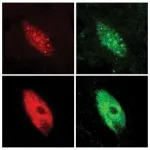SLAS Discovery's July special edition 'Drug discovery targeting COVID-19' now available
2021-06-30
(Press-News.org) Oak Brook, IL - The July edition of SLAS Discovery is a Special Edition featuring the cover article, "Development of a High-Throughput Screening Assay to Identify Inhibitors of the SARS-CoV-2 Guanine-N7-Methyltransferase Using RapidFire Mass Spectrometry" by Lesley-Anne Pearson, Charlotte J. Green, Ph.D., De Lin, Ph.D., Alain-Pierre Petit, Ph.D., David W. Gray, Ph.D., Victoria H. Cowling, Ph.D., and Euan A. F. Fordyce, Ph.D., (Drug Discovery Unit, School of Life Sciences, University of Dundee, Dundee, UK).
In January 2021, a survey of immunologists, infectious-disease researchers and virologists found that 90% of respondents believe SARS-CoV-2 will become endemic, continuing to circulate in pockets of the global population for years to come. Even as vaccines are becoming more widely available, there are people who either do not respond to the treatment or are not suitable for vaccination. There is a critical need to develop small molecule inhibitors for this pathogen.
The cover article highlights the work of the Drug Discovery Unit at the University of Dundee (Dundee, Scotland, UK) reporting on the development of a high-throughput biochemical assay to assess the impact of small molecules on the methyltransferase activity of SARS-CoV-2 nonstructural protein 14 (nsp14). This enzyme is responsible for the N7-methylation of the cap at the 5' end of viral RNA and is critical in helping coronaviruses evade host defenses. The label-free MS-based assay developed was used to screen a library of 1771 FDA-approved drugs. The chemical hits that were identified may serve as starting points for drug discovery programs aimed at delivering therapeutics for the SARS-CoV-2 virus.
The July issue of SLAS Discovery includes four articles of original research.
These include:
Development of a Novel Label-Free and High-Throughput Arginase-1 Assay Using Self-Assembled Monolayer Desorption Ionization Mass Spectrometry
A Solid Supported Membrane-Based Technology for Electrophysical Screening of B0 AT1-Modulating Compounds
Characterization of Transport Activity of SLC11 Transporters in Xenopus laevis Oocytes by Fluorophore Quenching
High-Throughput Phenotypic Assay for Compounds That Influence Mitochondrial Health Using iPSC-Derived Human Neurons
Other articles include:
Development of a High-Throughput Screening Assay to Identify Inhibitors of the SARS-CoV-2 Guanine-N7-Methyltransferase Using RapidFire Mass Spectrometry
A High-Throughput Radioactivity-Based Assay for Screening SARS-CoV-2 nsp10-nsp16 Complex
Label-Free Screening of SARS-CoV-2 NSP14 Exonuclease Activity Using SAMDI Mass Spectrometry
A Quantitative Bioassay to Determine the Inhibitory Potency of NGF-TrkA Antagonists
Access to July's SLAS Discovery issue is available at https://journals.sagepub.com/toc/jbxb/current.
For more information about SLAS and its journals, visit https://www.slas.org/publications/slas-discovery/ Access a "behind the scenes" look at the latest issue with SLAS Discovery Author Insights podcast. Tune in by visiting https://www.buzzsprout.com/1099559.
INFORMATION:
SLAS (Society for Laboratory Automation and Screening) is an international professional society of academic, industry and government life sciences researchers and the developers and providers of laboratory automation technology. The SLAS mission is to bring together researchers in academia, industry and government to advance life sciences discovery and technology via education, knowledge exchange and global community building.
SLAS Discovery: Advancing the Science of Drug Discovery, 2019 Impact Factor 2.195. Editor-in-Chief Robert M. Campbell, Ph.D., Twentyeight-Seven Therapeutics, Boston, MA (USA).
SLAS Technology: Translating Life Sciences Innovation, 2019 Impact Factor 2.174. Editor-in-Chief Edward Kai-Hua Chow, Ph.D., National University of Singapore (Singapore).
ELSE PRESS RELEASES FROM THIS DATE:
2021-06-30
Boulder, Colo., USA: GSA's dynamic online journal, Geosphere, posts articles online regularly. Locations and topics studied this month include the central Appalachian Mountains; fossil pollen in Colombia; the precision and accuracy of model analyses; the Bone Spring Formation, Permian Basin, west Texas; and the geochronology of modern river sediment in south-central Alaska. You can find these articles at https://geosphere.geoscienceworld.org/content/early/recent .
Spatially variable syn- and post-Alleghanian exhumation of the central Appalachian Mountains from zircon (U-Th)/He thermochronology
Luke C. Basler; Jaclyn S. Baughman; Michelle L. Fame; Peter J. Haproff
Abstract: To assess spatial and temporal patterns of Phanerozoic orogenic burial and subsequent ...
2021-06-30
Key Takeaways:
Research reveals consumer demand declines when product packaging and marketing materials removed the claim, "Made in USA" and increase when the claim was featured.
The impact on sales is insufficient to convince some companies to manufacture more products in the United States but enough to incentivize companies to make deceptive "Made in USA" claims.
CATONSVILLE, MD, June 30, 2021 - Pick up any product in just about any store and you're likely to find information that indicates the country of origin of the product. The U.S. Federal Trade Commission (FTC) requires this for any imported product, but not for products made in the United States. When you see the words "Made in USA" on a product, it's purely for marketing purposes. So, does it work?
According to a ...
2021-06-30
LA JOLLA--(June 30, 2021) Scientists--and gardeners--have long known that plants grow taller and flower sooner when they are shaded by close-growing neighbors. Now, for the first time, researchers at the Salk Institute have shown the detailed inner workings of this process.
The study, published June 17, 2021, in Nature Genetics, offers a new understanding of how gene activity directs plant growth, and how quickly plants respond to their environment--with shifting light conditions triggering molecular changes in as little as five minutes. The findings provide insights ...
2021-06-30
When it comes to defense, the body relies on attack thanks to the lymphatic and immune systems. The immune system is like the body's own personal police force as it hunts down and eliminates pathogenic villains.
"The body's immune system is very good at identifying cells that are acting strangely. These include cells that could develop into tumors or cancer in the future," says Federica Eduati from the department of Biomedical Engineering at TU/e. "Once detected, the immune system strikes and kills the cells."
Stopping the attack
But it's not always so straightforward as tumor cells can develop ways to hide themselves from the immune system.
"Unfortunately, tumor cells can block the ...
2021-06-30
Growing resistance to our go-to antibiotics is one of the biggest threats the world faces. As common bacteria like strep and salmonella become resistant to medications, what used to be easily treatable infections can now pose difficult medical challenges.
New research from the University of Georgia shows that there may be more antimicrobial-resistant salmonella in our food animals than scientists previously thought.
Using technology she developed, UGA researcher Nikki Shariat and Amy Siceloff, a first-year doctoral student in UGA's Department of Microbiology, found that traditional culturing methods used to test livestock for problematic bacteria often miss drug-resistant ...
2021-06-30
Since the onset of the COVID-19 pandemic last year, medical experts have stressed the importance of having a plan in the event of a positive test result. Where should you self-isolate? Do you have personal protective equipment for family members? Who should you notify about your diagnosis? An overwhelming 96% of healthy, educated adults surveyed by University of Houston researchers in the early stages of the pandemic did not have a comprehensive plan in mind, while 62% didn't have a plan at all.
"What that suggests is that it was difficult even for very high functioning people to digest and use all the complex information that was quickly emerging about ...
2021-06-30
Following the first wave of SARS-CoV-2 infections in spring 2020, Europe experienced a resurgence of the virus starting late summer. Although it appears clear that travel had a significant impact on the circulation of the virus, it remains challenging to assess how it may have restructured and reignited the epidemic in the different European countries.
In a new study published in the journal Nature this June 30th, 2021, Philippe Lemey - Rega Institute, KU Leuven, Simon Dellicour - SpELL, Spatial Epidemiology Lab, Université Libre de Bruxelles, and their collaborators, built a phylogeographic model to assess how newly introduced viral lineages, as opposed to ...
2021-06-30
Levelling up access to finance so that poorer countries can afford the funds needed to switch to renewable energy could see regions like Africa reaching net zero emissions a decade earlier, according to a study led by UCL researchers.
Access to finance (credit) is vital for the green energy transition needed to reduce global greenhouse gas emissions, as laid out in the Paris Agreement. But access to low-cost finance is uneven, with the cost of securing capital to help reach net zero differing substantially between regions.
Modelling created for the study, Higher cost of finance exacerbates a climate investment trap in developing economies, published in Nature Communications, ...
2021-06-30
HOUSTON - The University of Texas MD Anderson Cancer Center's Research Highlights provides a glimpse into recently published studies in basic, translational and clinical cancer research from MD Anderson experts. Current advances include expanded use of a targeted therapy for a new group of patients with leukemia, molecular studies yielding novel cancer therapeutic targets, insights into radiation therapy resistance and a community intervention to reduce cervical cancer rates.
Using acalabrutinib as initial treatment for chronic lymphocytic leukemia
Chronic lymphocytic leukemia (CLL) is a cancer that occurs in the blood, bone marrow, lymph nodes, liver and spleen. It is the most common leukemia in adults, and while there are treatments ...
2021-06-30
Heart attack, medically known as myocardial infarction (MI), is a common heart condition. MI is caused by problems in blood supply to parts of the heart. In severe cases, MI could be accompanied by ruptures in the wall separating different parts of the heart, such as in the ventricular septum (a wall that separates the right ventricle that pumps deoxygenated blood to the lungs for oxygenation, from the left ventricle that pumps oxygenated blood to rest of the body). Not surprisingly, without appropriate surgical intervention, a VSR due to MI increases the chances of death.
Current surgical techniques ...
LAST 30 PRESS RELEASES:
[Press-News.org] SLAS Discovery's July special edition 'Drug discovery targeting COVID-19' now available


